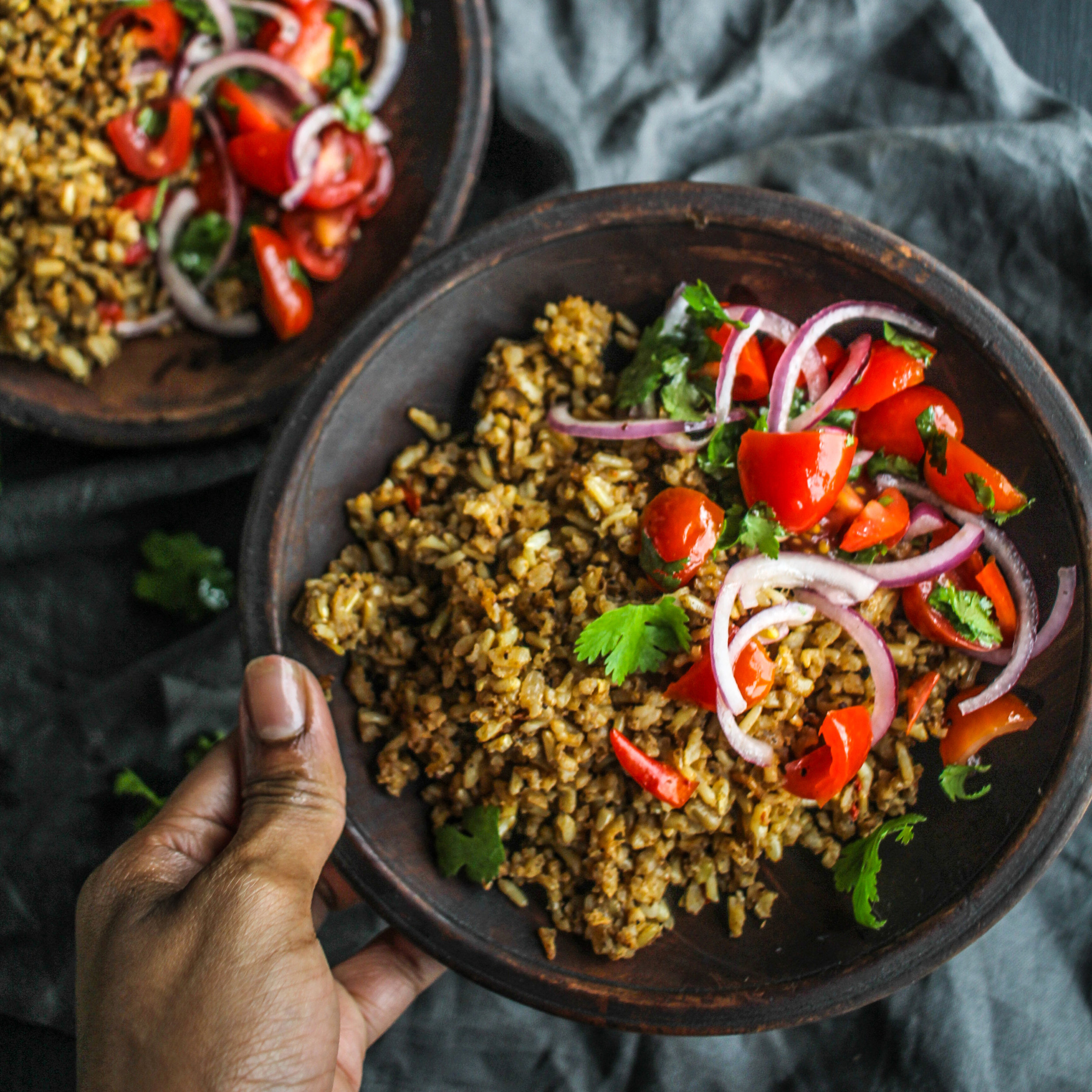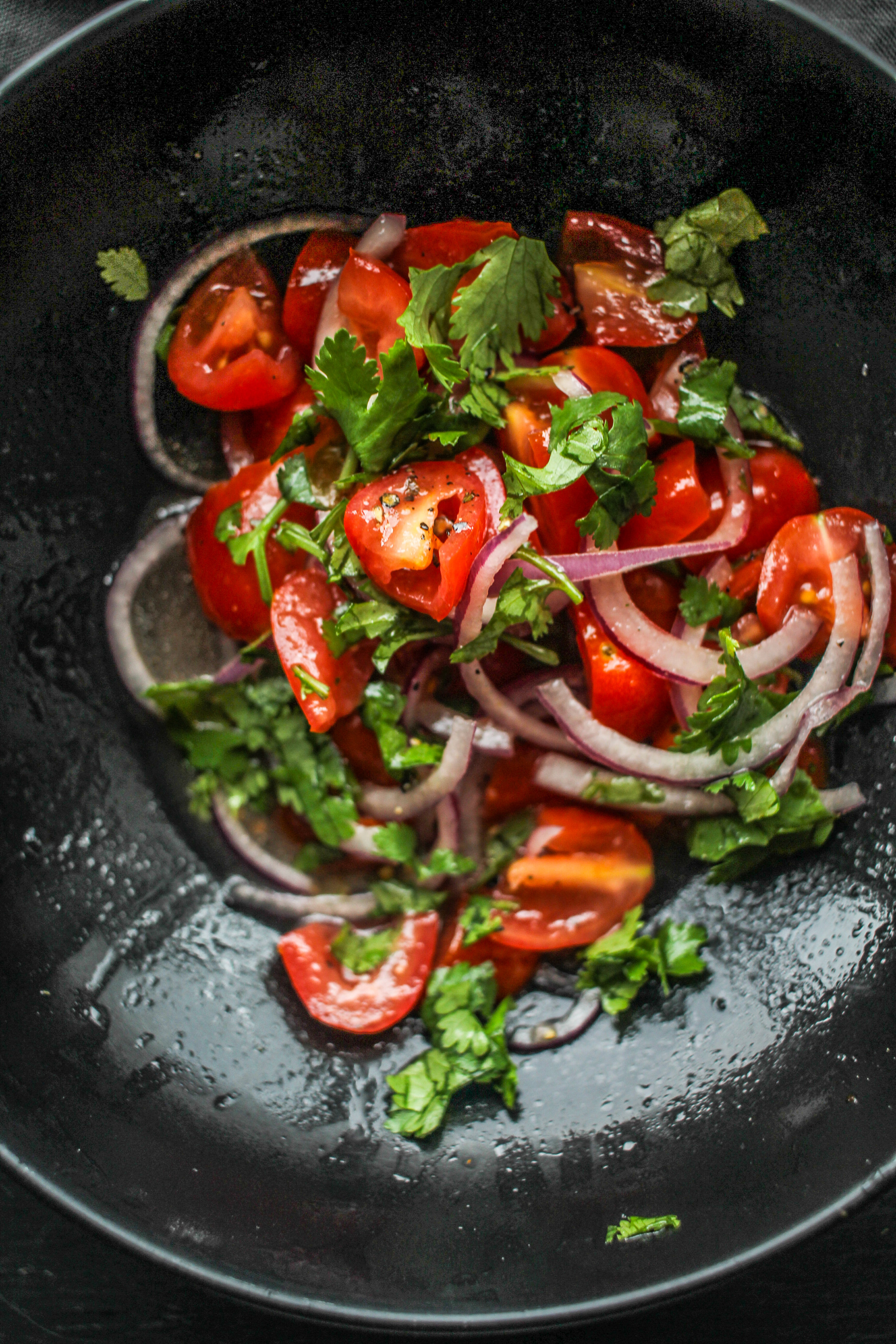Pilau Masala
In honor of Black History Month and my second year participating in the annual Black History Month Potluck, I thought it would be fun to promote more African cooking and Oldways. I get giddy recreating African dishes because many of them are already vegetarian-friendly, but more than that, they're built on simple, everyday ingredients--like garlic, onions, ginger, tomatoes--, ingredients that make it easy to pull together stoically -- it’s a bonus too, that we just so happen to feel real love for these flavors.I’m sitting here in the book nook of my living room, typing fast, rushing this recipe over to you because, gosh, I smell it simmering on my stovetop and I am just about to drift off the floor like my own Disney character to float with the flow of its draft. I toasted the spices--they’ve stained the cracks in my hands with their smell while gathering them from storage--, and when the warmed spices were finally crushed in the processor, oh, the kitchen filled with an aroma so deep it mimicked the warmth of the earth. Eric told me to tell you, “Mah Gawd, it smells so good!”Last year I whipped together aCreamy Peanut Stew with Oven-Fried Okra for the potluck, and this year I wanted to move beyond a one-hit recipe and challenge myself with ways to incorporate African flavors into my diet on the regular. When I thought more about how, it dawned on me that spice blends are the perfect singular ingredient for bringing the most impact to a dish, offering the staple ingredients that run through them direction and distinction. Tex-Mex blends (cumin, chili powder, onion powder, garlic powder), Mediterranean Blends (rosemary, cumin, oregano, dried mint), Indian Blends (cardamom, mustard seed, coriander, cumin, etc.), a mix of a few spices, and you can take a mild dish like bread or rice to an entirely different place, geographically and on your tongue. So I wanted to make some of my own African spice blends, store them, and then add them in, in a pinch (punning pretty hard over here, excuse me), to quickly contour a dish and also give the illusion it has been slow cooking for hours. I think you will really enjoy this pilau.About Pilau: Pilau is just another word used in East Africa to mean "pilaf", which as we know is a rice dish cooked in some type of broth after first being (sometimes) toasted in oil or butter to impart deeper flavor and some nice golden color.At first, I couldn't decide between making a Tanzanian pilau or a Kenyan pilau; both are quite different. Pilau in Tanzania is usually spiced with curries, cinnamon, cumin, hot peppers, and cloves. It is one of the most common base dishes seen in the country just after ugali, an even more widely eaten dish made from maize flour and stiffened like a type of American cornbread. Because rice is a starch only available to the more affluent areas of the country, it’s not consumed as much as ugali. The country’s diet is built on the backs of starches to help feed its population. I’m understanding that the biggest distinction between Kenyan pilau and the pilau in Tanzania is that Tanzanian pilau is made using coconut milk, a common ingredient seen throughout many of their dishes. Also the use of chilies and hot spices are popular in Tanzania the closer you get to the coast of Tanzania and the urban centers.If you follow me on Instagram, you’ll remember that I have been “quite taken” by Green Curry tofu this week, and so I already had stacks on stacks of canned coconut milk and fresh chilies on hand to quick-throw-some-curry-together-in-a-flash my cravings. This was my one impetus for going with the Tanzanian pilau this time; I got to see how far away from Thailand I could transport those same ingredients. Because Tanzania is so diverse, so is its cuisine, and you find influences of many other cultural cuisines mixed in (over 120 different ethnicities), Because of its many Indian inhabitant you’ll see similarities between, say, Garam masala, and this blend.Contradictory to what I said earlier about African cuisine and vegetarianism, this dish is actually often cooked with chunks of meat inside or grilled or fried fish on top because pilau is essentially a base dish/side dish.But more often than that, I've seen it paired with a type of pico called Kachumbari—which adds a nice brightness to the spicy and earthy rice (recipe below for this one too!) If I were to turn this into a meal myself, I would probably serve this with fried tofu, toasted cashews or roasted peanuts, crunchy chickpeas, or boiled potatoes instead. But for now, I'm content with focusing on it as the beautiful and elevated (in comparison to my own experience with boiled rice) side dish that it is.
Here is the list of other wonderful bloggers participating in this roundup!
See our table spread:Beautiful Eats & Things-Turkey Sausage Stuffed Collard Green WrapsBetter With Biscuits - Corn PuddingBeyond the Bayou Food Blog- Redfish CourtBoullion Brandi's Dairy- Better than Jiffy Cornbread from ScratchButter Be Ready- Southern Style Mac and CheeseChef Kenneth- Fried Sweet Potato Hand PieCooks With Soul- Braised Short Rib MeatloafD.M. R. Fine Foods- Cinnamon Raisin Bread PuddingDash of Jazz- Nigerian Jollof RiceDomestic Dee- Fried Peach Hand PiesEat. Drink.Frolic.- Olive Oil Collard GreensFood Fidelity- Mofongo RellenoFood is Love Made Edible - Buttermilk Biscuits with Fried Chicken and Tabasco HoneyHigh Heels and Good Meals- Crawfish EtouffeeHomeMadeZagat- Shrimp with Spicy Curry Cream SauceHouston Food Fetish- Sweet Almond Tea CakesIn the Kitchen w/Kmarie- Pineapple LemonadeMarisa Moore Nutrition- Bourbon Peach Glazed SalmonMeiko and The Dish- Candied Bourbon Peach CobblerMy Life Runs On Food- Lentil Soup and Roast OkraOrchids + Sweet Tea- Carrot and Zucchini Noodles Stir Fry with ShrimpRaised on Ramen- Orange Glazed Brussels SproutsSavory Spicerack- Creamy Fish StewSimply LaKita- Blackberry CobblerThe Hungry Hutch- Orange Bundt Cake with Vanilla GlazeThe Kitchenista Diaries- Smothered Turkey WingsThe Seasoning Bottle- Honey Turmeric Skillet Chicken
Here’s how to make this rice dish: (Recipe adapted from Miriam Kinunda’s Taste of Tanzania)Pilau Masala Spice Blend:
1 TBSP green Cardamom pods
5 whole cloves
1 1/2 tbsp cumin seeds
1/4 tsp coarsely ground black pepper
1 cinnamon stick, crushed
Pilau Rice:
2 tbsp oil or ghee
2 1/2 cups basmati rice (I used brown), rinsed
1 cup diced yellow onions
1 Tbsp chopped garlic
1 Tbsp chopped ginger
1/4 cup chopped red peppers
2 tbsp pilau masala spice blend
4 cups vegetable broth
1 cup canned coconut milk
1 ½ tsp salt
1-2 chiles, stemmed and halved (optional)
Kachumbari (pico):
½ cup diced tomatoes (I used grape tomatoes)
thinly sliced red onion
juice of 1 lemon
handful chopped cilantro
1-2 tbsp olive oil
S+ P, to taste
Directions:
Make the Spice Blend: In a skillet over medium heat, toast the spices for the pilau masala, stirring frequently, until the spices darken and begin to smoke, about 3-5 minutes.
Remove them from the heat and then transfer the spices to a food processor (or mortar and pestle OR spice grinder) and pulse until finely ground.
Make the Pilau: In a large skillet or pot, heat the oil or ghee, then add the chopped onions and rinsed basmati rice stirring until toasted, about 3-5 minutes. Add the garlic, ginger and red bell pepper, and 2 tbsp of the pilau masala blend, and continue to cook until fragrant, about 2 more minutes.
Add the vegetable broth, coconut milk, salt, and halved peppers if using.
Bring the rice to a boil, and then reduce the heat to low, cover with a lid, and cook for about 40 minutes or until the rice is tender and cooked through.
Fluff with a fork.
Make the Kachumbari:
In a bowl combine all the ingredients, and allow a 15-20 minutes to marinate, or until the onions begin to soften.
Serve and Enjoy! Xx








